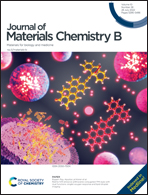PgC3Mg metal–organic cages functionalized hydrogels with enhanced bioactive and ROS scavenging capabilities for accelerated bone regeneration†
Abstract
The repair of large bone defects is an urgent problem in the clinic. Note that the disruption of redox homeostasis around bone defect sites might hinder the new bone reconstruction. The rational design of hydrogels for bone regeneration still faces the challenges of insufficient antioxidant capability and weak osteogenesis performance. Here, motivated by the versatile therapeutic functions of metal–organic cages, magnesium-seamed C-propylpyrogallol[4]arene (PgC3Mg) functionalized biodegradable and porous gelatin methacrylate (GelMA) hydrogels are constructed. The novel metal–organic cages endow hydrogels with highly bioactive characteristics and strong reactive oxygen species (ROS)-scavenging ability owing to the simultaneous release of bioactive Mg2+ ions and antioxidant phenolic hydroxyl-rich moieties. The in vitro results reveal that the PgC3Mg modified biocompatible hydrogels show higher expression of osteo-related genes and significantly eliminate the intracellular ROS levels of bone marrow-derived mesenchymal stem cells (BMSCs) against oxidative damage. Meanwhile, the bioactive and ROS scavenging hydrogels can accelerate bone regeneration in large cranial defects. Overall, this study may provide new insights into the designing of regenerative bone grafts with simultaneously enhanced osteogenic and antioxidant capabilities.



 Please wait while we load your content...
Please wait while we load your content...